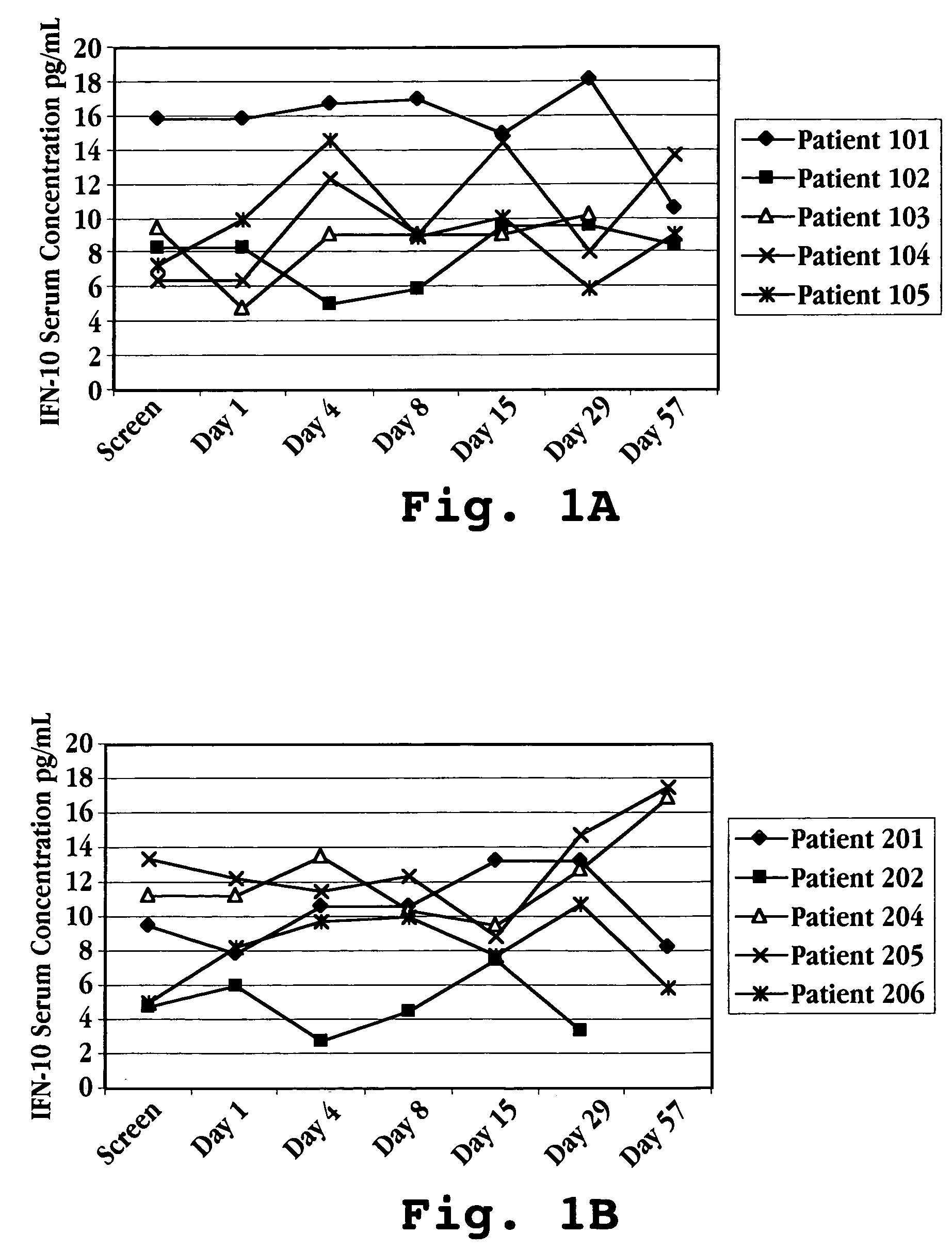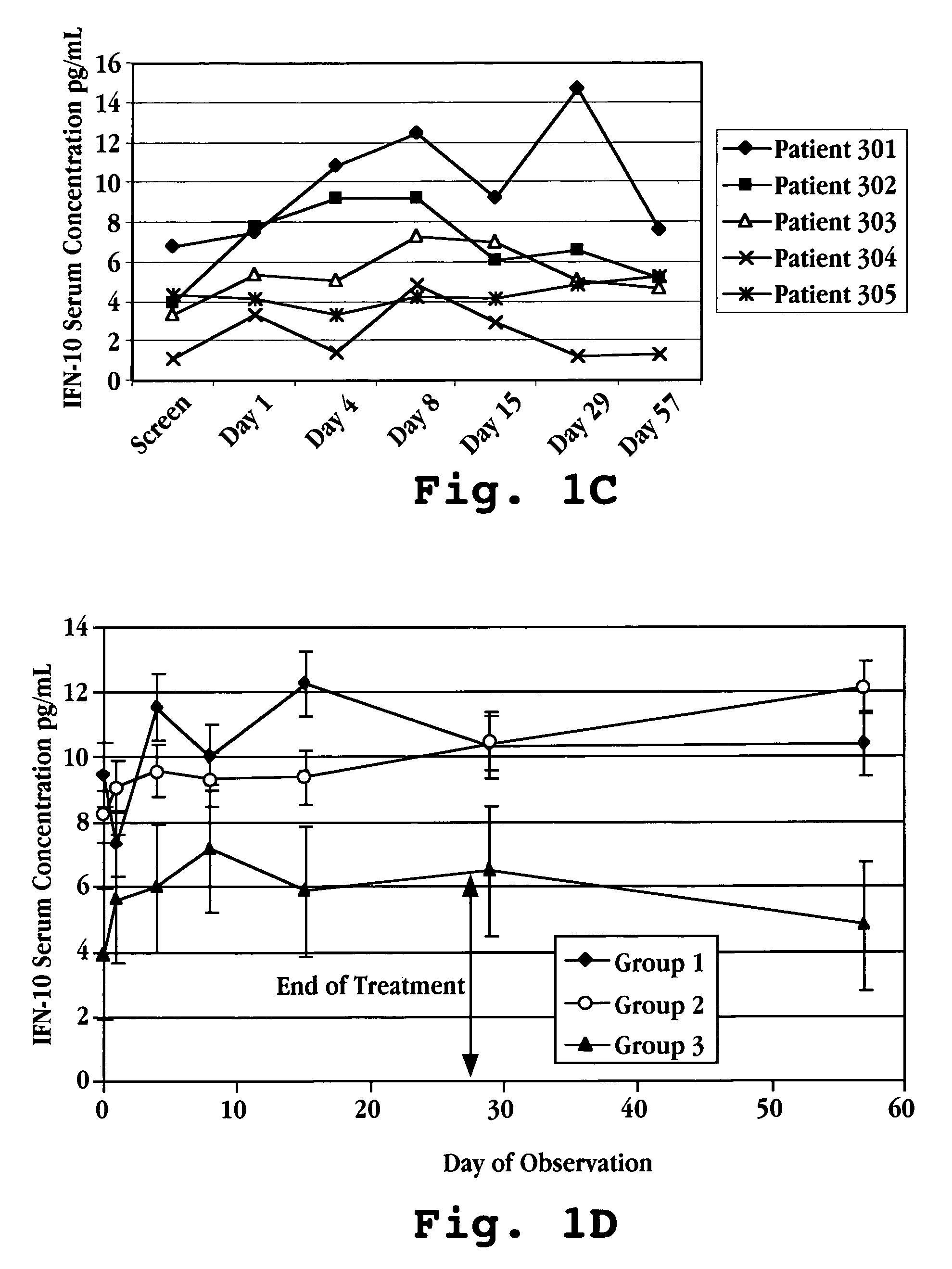Method of treatment using interferon-tau
a technology of interferon and treatment method, which is applied in the direction of biochemistry apparatus and processes, peptide/protein ingredients, microorganism testing/measurement, etc., can solve the problems of inability to provide a basis for drawing any expectations of ifn, difficulty in predicting whether ifn when administered to a human will provide a therapeutic benefit, and difficulty in determining whether ifn will be effective in treating the condition, etc., to achieve the effect of reducing
- Summary
- Abstract
- Description
- Claims
- Application Information
AI Technical Summary
Benefits of technology
Problems solved by technology
Method used
Image
Examples
example 1
Administration of IFNτ to Multiple Sclerosis Patients
[0156] Humans suffering from multiple sclerosis were enrolled in a trial for treatment with IFNτ. Fifteen patients were randomized into three treatment groups: Group I patients were given IFNτ orally at a dosage of 0.2 mg per day (2×107 U / day) Group II patients were given IFNτ orally at a dosage of 0.8 mg per day (8×107 U / day); and Group III patients were given IFNτ orally at a dosage of 1.8 mg per day (1.8×108 U / day).
[0157] Prior to treatment with IFNτ, on screening Day and Day 1 (one), a blood sample was taken from each subject to determine a baseline serum cytokine concentration. Treatment was initiated by administering IFNτ orally to each patient following the blood draw on Day 1. Prior to administration, the vials of IFNτ (SEQ ID NO:3) and syringes were kept in a refrigerator maintained at 2 to 8° C. Prior to self-administration of medication, the patient removed one vial and one syringe from the refrigerator. The cap was r...
example 2
Administration of IFNτ Three Times Daily to Human Patients Infected with Hepatitis C
[0163] A. IFNτ Preparation
[0164] On day one, one bottle of IFNτ (SEQ ID NO:3) was removed from the refrigerator and the patient self-administered the proper volume of test material according to Table 2. IFNτ (SEQ ID NO:2) may also be prepared and administered in the same manner.
TABLE 2Recombinant Ov-IFNτ Patient Dose AdministrationVolumeTotalTotalDoseNumber ofIFNτ(mL) perDailyDailyGroupPatients(mg / mL)Dose (TID)Dose (mg)Dose (U)I61.00.331.01 × 108II61.01.03.03 × 108III61.03.09.09 × 108
[0165] B. Patient Dosing Instructions
[0166] All vials of test material and syringes were kept in a refrigerator maintained at 2 to 8° C. Prior to the self-administration of medication, the patient removed one vial and one syringe from the refrigerator. The cap was removed from the tip of the syringe and the tip of the syringe was placed into the bottle of medication to withdraw the appropriate volume into the syring...
example 3
Administration of IFNτ Twice Daily to Patients Infected with Hepatatis C
[0177] Five patients infected with hepatitis C were recruited for a study. The patients were treated with IFNτ according to the method of Example 2, each patient received 7.5 mg twice daily, for a total daily dose of 15 mg (1.5×109 U). The first dose was taken in the morning, before breakfast. The second dose was taken at least three hours after an evening meal.
[0178] Blood samples were taken at defined intervals over the 113 day test period. The samples were analyzed for IL-10, IL-12, and IFN-γ levels in the serum using commercially available ELISA kits (Genzyme, Cambridge, Mass.). The results are shown in FIG. 7A (IL-10), FIG. 7B (IFN-γ), and in FIGS. 8A-8D (IL-10, IL-12, and IFN-γ) for each of the five patients.
PUM
| Property | Measurement | Unit |
|---|---|---|
| Mass | aaaaa | aaaaa |
| Angle | aaaaa | aaaaa |
| Weight | aaaaa | aaaaa |
Abstract
Description
Claims
Application Information
 Login to View More
Login to View More - R&D
- Intellectual Property
- Life Sciences
- Materials
- Tech Scout
- Unparalleled Data Quality
- Higher Quality Content
- 60% Fewer Hallucinations
Browse by: Latest US Patents, China's latest patents, Technical Efficacy Thesaurus, Application Domain, Technology Topic, Popular Technical Reports.
© 2025 PatSnap. All rights reserved.Legal|Privacy policy|Modern Slavery Act Transparency Statement|Sitemap|About US| Contact US: help@patsnap.com



